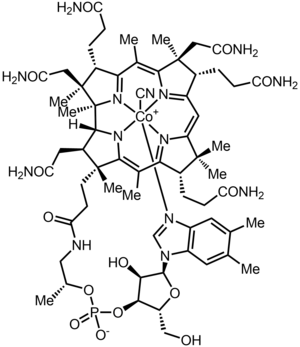Cyanocobalamin/ja: Difference between revisions
Created page with "{{chem|B|12r}}と{{chem|B|12s}}はシアノコバラミンから電位制御還元、またはアルカリ溶液中の水素化ホウ素ナトリウム、酢酸中の亜鉛を用いた化学還元、またはチオールの作用によって調製することができる。{{chem|B|12r}}も{{chem|B|12s}}も酸素のない条件下では無期限に安定である。{{chem|B|12r}}は溶液中では橙..." Tags: Mobile edit Mobile web edit |
Created page with "アデノシルコバラミンはメチルマロニル-CoAムターゼ-MUT酵素の補因子として必要である。コレステロールとタンパク質を処理するとプロピオニル-CoAが得られ、メチルマロニル-CoAに変換され、MUT酵素によってsuccinyl-CoA/ja|スクシニ..." Tags: Mobile edit Mobile web edit |
||
| (13 intermediate revisions by the same user not shown) | |||
| Line 122: | Line 122: | ||
{{chem|B|12r}}と{{chem|B|12s}}はシアノコバラミンから電位制御還元、またはアルカリ溶液中の[[sodium borohydride/ja|水素化ホウ素ナトリウム]]、[[acetic acid/ja|酢酸]]中の[[zinc/ja|亜鉛]]を用いた化学還元、または[[thiols/ja|チオール]]の作用によって調製することができる。{{chem|B|12r}}も{{chem|B|12s}}も酸素のない条件下では無期限に安定である。{{chem|B|12r}}は溶液中では橙褐色に、{{chem|B|12s}}は自然光の下では青緑色に、人工光の下では紫色に見える。 | {{chem|B|12r}}と{{chem|B|12s}}はシアノコバラミンから電位制御還元、またはアルカリ溶液中の[[sodium borohydride/ja|水素化ホウ素ナトリウム]]、[[acetic acid/ja|酢酸]]中の[[zinc/ja|亜鉛]]を用いた化学還元、または[[thiols/ja|チオール]]の作用によって調製することができる。{{chem|B|12r}}も{{chem|B|12s}}も酸素のない条件下では無期限に安定である。{{chem|B|12r}}は溶液中では橙褐色に、{{chem|B|12s}}は自然光の下では青緑色に、人工光の下では紫色に見える。 | ||
{{chem|B|12s}}は水溶液中で知られている最も求核性の高い種の一つである。この性質により、[[alkyl halide/ja|ハロゲン化アルキル]]やハロゲン化ビニルに対する[[nucleophilic/ja|求核]]攻撃によって、異なる[[substituents/ja|置換基]]を持つコバラミン類似体を簡便に調製することができる。 | |||
{{chem|B|12s}} | |||
例えば、シアノコバラミンは、{{chem|B|12s}}への還元を経て、対応する[[alkyl halides/ja|ハロゲン化アルキル]]、[[acyl halides/ja|ハロゲン化アシル]]、[[alkene/ja|アルケン]]または[[alkyne/ja|アルキン]]の付加によって、その類似体であるコバラミンに変換することができる。[[Steric hindrance/ja|立体障害]]は{{chem|B|12}}補酵素アナログの合成における主要な制限因子である。例えば、[[neopentyl/ja|ネオペンチル]]クロリドと{{chem|B|12s}}の反応は起こらないが、第二級アルキルハライド類似体は不安定で単離できない。この効果は、[[benzimidazole/ja|ベンズイミダゾール]]と中心コバルト原子が強く配位し、コバルト原子を[[corrin/ja|コリン]]環の平面に引き下げるためと考えられる。[[trans effect/ja|トランス効果]]は、このようにして形成されたCo-C結合の分極率を決定する。しかし、いったん[[methyl iodide/ja|ヨウ化メチル]]による4級化によって[[benzimidazole/ja|ベンズイミダゾール]]がコバルトから切り離されると、{{chem|H|2|O}}または[[hydroxyl/ja|ヒドロキシル]]イオンで置換される。その後、様々な第二級アルキルハライドが修飾された{{chem|B|12s}}によって容易に攻撃され、対応する安定なコバラミンアナログが得られる。生成物は通常、フェノール-塩化メチレン抽出またはカラムクロマトグラフィーによって抽出・精製される。 | |||
この方法で調製されるコバラミン類似体には、天然に存在する補酵素[[methylcobalamin/ja|メチルコバラミン]]や[[cobamamide/ja|コバミド]]のほか、ビニルコバラミン、カルボキシメチルコバラミン、シクロヘキシルコバラミンなど、天然には存在しないコバラミンも含まれる。この反応は、[[chemical dehalogenation/ja|化学的脱ハロゲン化]]、有機試薬、光増感触媒系の触媒としての利用が検討されている。 | |||
==生産== | |||
{{Anchor|Production}} | |||
シアノコバラミンは[[bacterial fermentation/ja|細菌発酵]]によって商業的に調製される。様々な[[microorganism/ja|微生物]]による発酵により、[[methylcobalamin/ja|メチルコバラミン]]、[[hydroxocobalamin/ja|ヒドロキソコバラミン]]、[[adenosylcobalamin/ja|アデノシルコバラミン]]の混合物が得られる。これらの化合物は[[sodium nitrite/ja|亜硝酸ナトリウム]]と熱の存在下で[[potassium cyanide/ja|シアン化カリウム]]を加えることでシアノコバラミンに変換される。''[[Propionibacterium/ja|プロピオニバクテリウム]]''の複数種は[[exotoxin/ja|外毒素]]や[[endotoxin/ja|内毒素]]を産生せず、[[United States Food and Drug Administration/ja|米国食品医薬品局]]から[[GRAS/ja|GRAS]](一般に安全とみなされる)ステータスを与えられているため、ビタミン{{化学物質|B|12}}の生産に好ましい細菌発酵生物である。 | |||
歴史的に、生理学的形態は当初シアノコバラミンであると考えられていた。これは、細菌によって生産された[[hydroxocobalamin/ja|ヒドロキソコバラミン]]が細菌培養物から分離した後、[[activated charcoal/ja|活性炭]]カラムで精製中にシアノコバラミンに変化したためである([[cyanide/ja|シアン化物]]は活性炭に天然に存在するため)。シアノコバラミンがほとんどの医薬品製剤に含まれるのは、シアンを加えることで分子が安定するからである。 | |||
2008年のビタミンB<sub>12</sub>の世界総生産量は、4社(フランスのサノフィ・アベンティス社と中国の3社)で35トンであった。 | |||
== 代謝 == | |||
{{Anchor|Metabolism}} | |||
ビタミン{{chem|B|12}}の2つの生理活性型は、[[cytosol/ja|サイトゾル]]中の[[methylcobalamin/ja|メチルコバラミン]]と[[mitochondria/ja|ミトコンドリア]]中の[[adenosylcobalamin/ja|アデノシルコバラミン]]である。マルチビタミンにはシアノコバラミンが含まれていることが多いが、これは体内で生理活性型に変換されると推定されている。メチルコバラミンもアデノシルコバラミンもサプリメントの錠剤として市販されている。[[MMACHC/ja|MMACHC]]遺伝子産物は、シアノコバラミンの脱シアン化と、メチルコバラミンやアデノシルコバラミンなどのアルキルコバラミン類の脱アルキル化を触媒する。この機能は、[[Cyanocobalamin reductase (cyanide-eliminating)/ja|コバラミン還元酵素]]にも起因している。MMACHC遺伝子産物とコバラミン還元酵素はシアノコバラミンとアルキルコバラミンの相互変換を可能にする。 | |||
シアノコバラミンは、人間用の粉ミルク、朝食用シリアル、[[energy drinks/ja|エナジードリンク]]などの栄養強化のために添加されるほか、家禽、豚、魚の飼料にも使用される。ビタミン{{chem|B||12}}は、タバコの煙に含まれる[[hydrogen cyanide/ja|シアン化水素]]や[[nitric oxide/ja|一酸化窒素]]によって不活性化する。ビタミン{{chem|B|12}}は[[nitrous oxide/ja|亜酸化窒素]]によっても不活性化する。{{chem|N|2|O}}は一般に笑気ガスとして知られ、[[anaesthesia/ja|麻酔]]や娯楽薬物として使用される。ビタミン{{chem|B|12}}は電子レンジなどの加熱により不活性化する。 | |||
=== 細胞質内 === | |||
[[Methylcobalamin/ja|メチルコバラミン]]と[[5-methyltetrahydrofolate/ja|5-メチルテトラヒドロ葉酸]]は、[[methionine/ja|メチオニン]]サイクルで[[methionine synthase/ja|メチオニン合成酵素]]が[[5-methyltetrahydrofolate/ja|5-メチルテトラヒドロ葉酸]]から[[homocysteine/ja|ホモシステイン]]にメチル基を転移させ、それによって[[tetrahydrofolate/ja|テトラヒドロ葉酸]](THF)と[[methionine/ja|メチオニン]]を生成し、[[SAMe/ja|SAMe]]を作るのに使われる。[[SAMe/ja|SAMe]]は万能のメチル供与体であり、[[DNA methylation/ja|DNAのメチル化]]や[[lipid bilayer/ja|リン脂質]][[cell membrane/ja|膜]]、[[choline/ja|コリン]]、[[sphingomyelin/ja|スフィンゴミエリン]]、[[acetylcholine/ja|アセチルコリン]]などの[[neurotransmitters/ja|神経伝達物質]]を作るのに使われる。 | |||
[[Methylcobalamin]] | |||
=== ミトコンドリア内 === | |||
[[File:Odd-chain FA oxydation.png|thumb|upright|[[mitochondrion/ja|ミトコンドリア]]-コレステロールにおけるビタミン{{chem|B|12}} [[adenosylcobalamin/ja|アデノシルコバラミン]] とタンパク質の代謝]] | |||
[[File:Odd-chain FA oxydation.png|thumb|upright| | |||
{{chem|B|12}}を内蔵補因子として使う酵素としては、[[methylmalonyl-CoA mutase/ja|メチルマロニル-CoAムターゼ]]([[Protein Data Bank/ja|PDB]] 4REQ)と[[methionine synthase/ja|メチオニン合成酵素]]([[Protein Data Bank/ja|PDB]] 1Q8J)がある。 | |||
[[propionyl-CoA/ja|プロピオニル-CoA]]の代謝はミトコンドリアで起こり、[[succinyl-CoA/ja|スクシニル-CoA]]を作るためにはビタミン{{chem|B|12}}([[adenosylcobalamin/ja|アデノシルコバラミン]]として)が必要である。ビタミン{{chem|B|12}}の欠乏によりミトコンドリアでのプロピオニル-CoAからスクシニル-CoAへの変換がうまくいかないと、[[methylmalonic acid/ja|メチルマロン酸]](MMA)の血中濃度の上昇が起こる。したがって、[[homocysteine/ja|ホモシステイン]]とMMAの血中濃度の上昇は、どちらも[[vitamin B12 deficiency/ja|ビタミン{{chem|B|12}}欠乏症]]の指標となりうる。 | |||
[[Adenosylcobalamin/ja|アデノシルコバラミン]]は[[methylmalonyl-CoA mutase/ja|メチルマロニル-CoAムターゼ]]-MUT酵素の[[cofactor (biochemistry)/ja|補因子]]として必要である。コレステロールとタンパク質を処理すると[[propionyl-CoA/ja|プロピオニル-CoA]]が得られ、[[methylmalonyl-CoA/ja|メチルマロニル-CoA]]に変換され、[[methylmalonyl-CoA mutase/ja|MUT酵素]]によって[[succinyl-CoA/ja|スクシニル-CoA]]が作られる。赤血球中のヘモグロビンを生成するために[[mitochondria/ja|ミトコンドリア]]で[[porphyrin/ja|ポルフィリン]]と[[heme/ja|ヘム]]を作るのはビタミン{{chem|B|12}}によって作られる[[succinyl-CoA/ja|スクシニル-CoA]]に依存するため、貧血を防ぐためにはビタミン{{chem|B|12}}が必要である。 | |||
[[Adenosylcobalamin]] | |||
=== 吸収と輸送 === | === 吸収と輸送 === | ||
Latest revision as of 10:13, 7 April 2024
 | |
 結晶構造に基づくシアノコバラミンのスティックモデル | |
| Clinical data | |
|---|---|
| Pronunciation | sye AN oh koe BAL a min |
| Trade names | Cobolin-M, Depo-Cobolin, others |
| AHFS/Drugs.com | Professional Drug Facts |
| MedlinePlus | a604029 |
| License data | |
| Pregnancy category |
|
| Routes of administration | By mouth/ja, intramuscular/ja, nasal spray/ja |
| ATC code | |
| Legal status | |
| Legal status |
|
| Identifiers | |
| CAS Number | |
| PubChem CID | |
| DrugBank | |
| ChemSpider | |
| UNII | |
| KEGG | |
| ChEMBL | |
| Chemical and physical data | |
| Formula | C63H88CoN14O14P |
| Molar mass | 1355.388 g·mol−1 |
| 3D model (JSmol) | |
| Melting point | 300 °C (572 °F) + |
| Boiling point | 300 °C (572 °F) + |
| Solubility in water | 1/80g/ml |
| |
| |
シアノコバラミン(Cyanocobalamin)は、ビタミンB
12欠乏症の治療と予防に用いられるビタミンB
12欠乏症の防止に使われる。欠乏症は、悪性貧血、胃の外科的切除後、魚条虫、または腸がんに起因して起こることがある。経口、筋肉への注射、または点鼻薬として使用される。
シアノコバラミンは一般に忍容性が高い。軽度の副作用には、下痢、吐き気、胃のむかつき、かゆみなどがある。重篤な副作用には、アナフィラキシー、心不全を引き起こす低血中カリウムなどがある。コバルトアレルギーのある人やレーバー病の人には使用は推奨されない。過量投与や毒性は報告されていない。ビタミンB
12欠乏症の治療には、ヒドロキソコバラミンよりもバイオアベイラビリティがやや低いため、あまり好まれない。降圧作用があることを示した研究もある。
シアノコバラミンが最初に製造されたのは1940年代である。ジェネリック医薬品や市販薬として入手可能である。2021年には、5 万件以上の処方で、米国で110番目によく処方される医薬品であった。
医療用途
シアノコバラミンは通常、胃または腸の一部または全部を外科的に切除した後に処方され、ビタミンB
12の十分な血清レベルを確保する。また、悪性貧血、ビタミンB
12欠乏症(食物からの摂取量が少ないか、遺伝的またはその他の要因で吸収できないため)、甲状腺中毒症、出血、悪性腫瘍、肝疾患、腎疾患の治療にも用いられる。シアノコバラミン注射薬は、小腸の一部をバイパスした胃バイパス患者に処方されることが多く、B
12を食物やビタミンから摂取することが困難になっている。シアノコバラミンは、ビタミンB
12を吸収する能力をチェックするシリングテストを行うためにも使用される。
シアノコバラミンもまた、ヒドロキシコバラミンを青酸中毒の治療に静脈内投与した後に体内で生成される(そして尿を介して排泄される)。
副作用
シアノコバラミン注射の起こりうる副作用には、じんましん、呼吸困難などのアレルギー反応、顔の発赤、腕、手、足、足首または下肢の腫れ、極度の口渇、および下痢が含まれる。重篤でない副作用には、頭痛、めまい、下肢痛、かゆみ、または発疹がある。
ビタミンB
12欠乏を同時に伴う巨赤芽球性貧血の治療にB
12ビタミン(シアノコバラミンも含む)を用いると、貧血解消時に赤血球産生の亢進とそれに伴うカリウムの細胞内取り込みにより低カリウム血症になる可能性がある。シアノコバラミンで治療した場合、リーバー病患者は重篤な視神経萎縮を発症し、失明に至る可能性がある。
化学
ビタミンB
12は、ビタミンB
12のあらゆるビタマーの「総称記述子」名である。ヒトを含む動物はシアノコバラミンを活性型ビタミンB
12化合物のいずれかに変換することができる。
シアノコバラミンはビタミンB
12ファミリー(体内に入れるとB
12として機能する化学物質のファミリー)の中で最も広く製造されているビタマーの一つであり、その理由はシアノコバラミンがB
12の中で最も空気中で安定だからである。細菌発酵によって生成された後、精製するのが最も簡単である。それは暗い赤色の結晶として、または非晶質の赤い粉末として得ることができる。シアノコバラミンは無水形態で吸湿性であり、水にはほとんど溶けない(1:80)。それは121 °C (250 °F)で短時間のオートクレーブに対して安定である。ビタミンB
12である。補酵素は光に不安定である。消費された後、シアン化物配位子は他の基(アデノシル、メチル)に置換され、生物学的に活性な形態を作り出す。シアン化物はチオシアン酸塩に変換され、腎臓から排泄される。
化学反応

コバラミンでは、コバルトは通常3価のCo(III)の状態で存在する。しかし、還元条件下では、コバルト中心はCo(II)、あるいはCo(I)に還元され、通常、それぞれ還元型、超還元型を表すB
12r、B
12sと表記される。
B
12rとB
12sはシアノコバラミンから電位制御還元、またはアルカリ溶液中の水素化ホウ素ナトリウム、酢酸中の亜鉛を用いた化学還元、またはチオールの作用によって調製することができる。B
12rもB
12sも酸素のない条件下では無期限に安定である。B
12rは溶液中では橙褐色に、B
12sは自然光の下では青緑色に、人工光の下では紫色に見える。
B
12sは水溶液中で知られている最も求核性の高い種の一つである。この性質により、ハロゲン化アルキルやハロゲン化ビニルに対する求核攻撃によって、異なる置換基を持つコバラミン類似体を簡便に調製することができる。
例えば、シアノコバラミンは、B
12sへの還元を経て、対応するハロゲン化アルキル、ハロゲン化アシル、アルケンまたはアルキンの付加によって、その類似体であるコバラミンに変換することができる。立体障害はB
12補酵素アナログの合成における主要な制限因子である。例えば、ネオペンチルクロリドとB
12sの反応は起こらないが、第二級アルキルハライド類似体は不安定で単離できない。この効果は、ベンズイミダゾールと中心コバルト原子が強く配位し、コバルト原子をコリン環の平面に引き下げるためと考えられる。トランス効果は、このようにして形成されたCo-C結合の分極率を決定する。しかし、いったんヨウ化メチルによる4級化によってベンズイミダゾールがコバルトから切り離されると、H
2Oまたはヒドロキシルイオンで置換される。その後、様々な第二級アルキルハライドが修飾されたB
12sによって容易に攻撃され、対応する安定なコバラミンアナログが得られる。生成物は通常、フェノール-塩化メチレン抽出またはカラムクロマトグラフィーによって抽出・精製される。
この方法で調製されるコバラミン類似体には、天然に存在する補酵素メチルコバラミンやコバミドのほか、ビニルコバラミン、カルボキシメチルコバラミン、シクロヘキシルコバラミンなど、天然には存在しないコバラミンも含まれる。この反応は、化学的脱ハロゲン化、有機試薬、光増感触媒系の触媒としての利用が検討されている。
生産
シアノコバラミンは細菌発酵によって商業的に調製される。様々な微生物による発酵により、メチルコバラミン、ヒドロキソコバラミン、アデノシルコバラミンの混合物が得られる。これらの化合物は亜硝酸ナトリウムと熱の存在下でシアン化カリウムを加えることでシアノコバラミンに変換される。プロピオニバクテリウムの複数種は外毒素や内毒素を産生せず、米国食品医薬品局からGRAS(一般に安全とみなされる)ステータスを与えられているため、ビタミンTemplate:化学物質の生産に好ましい細菌発酵生物である。
歴史的に、生理学的形態は当初シアノコバラミンであると考えられていた。これは、細菌によって生産されたヒドロキソコバラミンが細菌培養物から分離した後、活性炭カラムで精製中にシアノコバラミンに変化したためである(シアン化物は活性炭に天然に存在するため)。シアノコバラミンがほとんどの医薬品製剤に含まれるのは、シアンを加えることで分子が安定するからである。
2008年のビタミンB12の世界総生産量は、4社(フランスのサノフィ・アベンティス社と中国の3社)で35トンであった。
代謝
ビタミンB
12の2つの生理活性型は、サイトゾル中のメチルコバラミンとミトコンドリア中のアデノシルコバラミンである。マルチビタミンにはシアノコバラミンが含まれていることが多いが、これは体内で生理活性型に変換されると推定されている。メチルコバラミンもアデノシルコバラミンもサプリメントの錠剤として市販されている。MMACHC遺伝子産物は、シアノコバラミンの脱シアン化と、メチルコバラミンやアデノシルコバラミンなどのアルキルコバラミン類の脱アルキル化を触媒する。この機能は、コバラミン還元酵素にも起因している。MMACHC遺伝子産物とコバラミン還元酵素はシアノコバラミンとアルキルコバラミンの相互変換を可能にする。
シアノコバラミンは、人間用の粉ミルク、朝食用シリアル、エナジードリンクなどの栄養強化のために添加されるほか、家禽、豚、魚の飼料にも使用される。ビタミンB
12は、タバコの煙に含まれるシアン化水素や一酸化窒素によって不活性化する。ビタミンB
12は亜酸化窒素によっても不活性化する。N
2Oは一般に笑気ガスとして知られ、麻酔や娯楽薬物として使用される。ビタミンB
12は電子レンジなどの加熱により不活性化する。
細胞質内
メチルコバラミンと5-メチルテトラヒドロ葉酸は、メチオニンサイクルでメチオニン合成酵素が5-メチルテトラヒドロ葉酸からホモシステインにメチル基を転移させ、それによってテトラヒドロ葉酸(THF)とメチオニンを生成し、SAMeを作るのに使われる。SAMeは万能のメチル供与体であり、DNAのメチル化やリン脂質膜、コリン、スフィンゴミエリン、アセチルコリンなどの神経伝達物質を作るのに使われる。
ミトコンドリア内

12 アデノシルコバラミン とタンパク質の代謝
B
12を内蔵補因子として使う酵素としては、メチルマロニル-CoAムターゼ(PDB 4REQ)とメチオニン合成酵素(PDB 1Q8J)がある。
プロピオニル-CoAの代謝はミトコンドリアで起こり、スクシニル-CoAを作るためにはビタミンB
12(アデノシルコバラミンとして)が必要である。ビタミンB
12の欠乏によりミトコンドリアでのプロピオニル-CoAからスクシニル-CoAへの変換がうまくいかないと、メチルマロン酸(MMA)の血中濃度の上昇が起こる。したがって、ホモシステインとMMAの血中濃度の上昇は、どちらもビタミンB
12欠乏症の指標となりうる。
アデノシルコバラミンはメチルマロニル-CoAムターゼ-MUT酵素の補因子として必要である。コレステロールとタンパク質を処理するとプロピオニル-CoAが得られ、メチルマロニル-CoAに変換され、MUT酵素によってスクシニル-CoAが作られる。赤血球中のヘモグロビンを生成するためにミトコンドリアでポルフィリンとヘムを作るのはビタミンB
12によって作られるスクシニル-CoAに依存するため、貧血を防ぐためにはビタミンB
12が必要である。
吸収と輸送
ビタミンB
12の不十分な吸収はセリアック病と関係があるかもしれない。ビタミンB
12の腸管吸収には3つの異なるタンパク質分子が必要である: ハプトコリン、内在因子、トランスコバラミンIIである。
こちらも参照